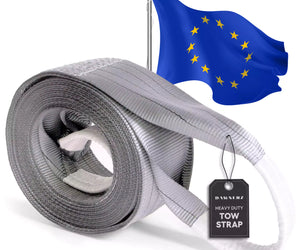

Reading blogs and brand websites, you'll notice a pattern - companies that sell polyester straps will tell you polyester is best, while companies selling nylon straps swear by nylon. In reality, there's no single "best" strap. If you use any strap incorrectly - in the wrong environment, over or under the vehicle's capacity, or with poor technique - it's going to fail regardless of its material, stretch, or fancy safety features.
Tow straps, recovery straps, kinetic ropes - they all serve different purposes based on what you actually need to do. There's no one-size-fits-all solution. We've put together a straight take on the real differences and when each type works best (or when it doesn't).
Polyester Recovery Tow Straps
What they do:
- Stretch only 3–5% under load
- Deliver a slow, controlled pull
- Keep full strength even when wet
- Work well for steady, predictable recoveries
Best for:
- Jobs that require precision and control
- Vehicles carrying loads that can’t shift around
- Wet or damp conditions where strength matters
- Pairing with winches or come-alongs
- Heavy equipment that needs careful handling
Downsides:
- Recovery vehicle must maintain traction
- Can be harder to get momentum started
- If your tires spin, you’re done
Nylon Snatch/Recovery Straps
What they do:
- Stretch 15–20% under load
- Let you build momentum before the strap tightens
- Store energy in the stretch, then release it
- Create the snap-pull effect that breaks vehicles free
Best for:
- Recoveries where traction is questionable
- Soft ground like mud, snow, or sand
- Quick pulls on lighter vehicles
- Situations where steady pulling just spins the tires
Downsides:
- Lose 20–30% of strength when wet
- Harder to control the force of the pull
- Sudden jerks can shift loads or damage mounts
- Less suited for delicate recovery jobs
Which One Should You Use?
Go with polyester if:
- You’ve got solid ground and good traction
- You’re moving a heavy or loaded vehicle
- You want maximum control over the pull
- You’re working in wet environments
Go with nylon if:
- Your recovery truck keeps losing traction
- Conditions are too soft for steady pulling
- You need momentum to get things moving
- You’re recovering lighter vehicles
Bottom Line
Both strap types have a place. Polyester gives control and consistency; nylon provides shock-loading and momentum. Most operators keep both on hand because the right tool depends on the terrain, traction, and weight of the recovery.
Always match the strap to the vehicle’s weight, inspect before every use, and avoid exceeding the Working Load Limit.

